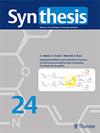A Practical Synthetic Approach to Chiral (α-Chloroalkyl)boronic Esters via Iridium-Catalyzed Chemoselective Hydrogenation of Chloro-Substituted Alkenyl Boronates
IF 2.2
4区 化学
Q2 CHEMISTRY, ORGANIC
引用次数: 13
Abstract
Chiral (α-chloroalkyl)boronic esters are obtained by homogeneous asymmetric iridium-catalyzed chemoselective hydrogenation of (1-chloro-1-alkenyl)boronic esters. P,N–Iridium catalysis provides low level of dehalogenation during the hydrogenation, while the catalyst activity and enantioselectivity essentially depends on the applied P,N ligand features. Fine tuning of P,N ligand structures enables high conversions, broad substrate acceptance, and high to excellent enantioselectivities with enantiomeric excess values up to 94% along with low levels of dechlorination. Low catalyst loading with S/C = 200 can also be achieved for the preparation of an industrially important isobutyl derivative.用铱催化氯取代烯基硼酸盐化学选择性加氢合成手性(α-氯烷基)硼酯的实用方法
采用均相不对称铱催化(1-氯-1-烯基)硼酯的化学选择性加氢反应制备手性(α-氯-烷基)硼酯。P,N -铱催化在加氢过程中提供低水平的脱卤,而催化剂活性和对映选择性主要取决于所应用的P,N配体特征。P,N配体结构的微调可实现高转化率,广泛的底物接受度,以及高至优异的对映体选择性,对映体过量值高达94%,同时脱氯水平低。低催化剂负载(S/C = 200)也可用于制备工业上重要的异丁基衍生物。
本文章由计算机程序翻译,如有差异,请以英文原文为准。
求助全文
约1分钟内获得全文
求助全文
来源期刊

Synthesis-Stuttgart
化学-有机化学
CiteScore
4.50
自引率
7.70%
发文量
435
审稿时长
1 months
期刊介绍:
SYNTHESIS is an international full-paper journal devoted to the advancement of the science of chemical synthesis. It covers all fields of organic chemistry involving synthesis, including catalysis, organometallic, medicinal, biological, and photochemistry, but also related disciplines. SYNTHESIS provides dependable research results with detailed and reliable experimental procedures and full characterization of all important new products as well as scientific primary data.
 求助内容:
求助内容: 应助结果提醒方式:
应助结果提醒方式:


